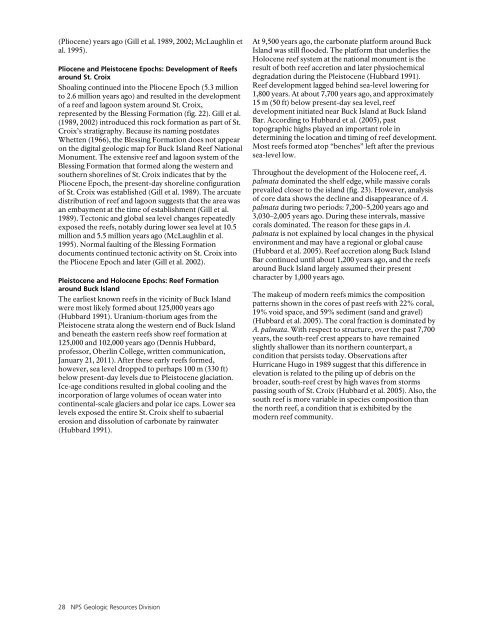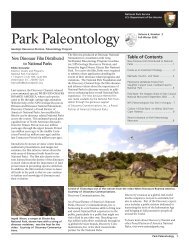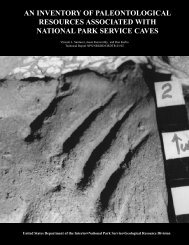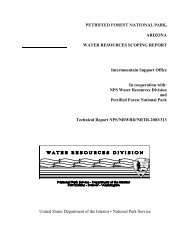Buck Island Reef National Monument Geologic Resources Inventory
Buck Island Reef National Monument Geologic Resources Inventory
Buck Island Reef National Monument Geologic Resources Inventory
You also want an ePaper? Increase the reach of your titles
YUMPU automatically turns print PDFs into web optimized ePapers that Google loves.
(Pliocene) years ago (Gill et al. 1989, 2002; McLaughlin et<br />
al. 1995).<br />
Pliocene and Pleistocene Epochs: Development of <strong>Reef</strong>s<br />
around St. Croix<br />
Shoaling continued into the Pliocene Epoch (5.3 million<br />
to 2.6 million years ago) and resulted in the development<br />
of a reef and lagoon system around St. Croix,<br />
represented by the Blessing Formation (fig. 22). Gill et al.<br />
(1989, 2002) introduced this rock formation as part of St.<br />
Croix’s stratigraphy. Because its naming postdates<br />
Whetten (1966), the Blessing Formation does not appear<br />
on the digital geologic map for <strong>Buck</strong> <strong>Island</strong> <strong>Reef</strong> <strong>National</strong><br />
<strong>Monument</strong>. The extensive reef and lagoon system of the<br />
Blessing Formation that formed along the western and<br />
southern shorelines of St. Croix indicates that by the<br />
Pliocene Epoch, the present-day shoreline configuration<br />
of St. Croix was established (Gill et al. 1989). The arcuate<br />
distribution of reef and lagoon suggests that the area was<br />
an embayment at the time of establishment (Gill et al.<br />
1989). Tectonic and global sea level changes repeatedly<br />
exposed the reefs, notably during lower sea level at 10.5<br />
million and 5.5 million years ago (McLaughlin et al.<br />
1995). Normal faulting of the Blessing Formation<br />
documents continued tectonic activity on St. Croix into<br />
the Pliocene Epoch and later (Gill et al. 2002).<br />
Pleistocene and Holocene Epochs: <strong>Reef</strong> Formation<br />
around <strong>Buck</strong> <strong>Island</strong><br />
The earliest known reefs in the vicinity of <strong>Buck</strong> <strong>Island</strong><br />
were most likely formed about 125,000 years ago<br />
(Hubbard 1991). Uranium-thorium ages from the<br />
Pleistocene strata along the western end of <strong>Buck</strong> <strong>Island</strong><br />
and beneath the eastern reefs show reef formation at<br />
125,000 and 102,000 years ago (Dennis Hubbard,<br />
professor, Oberlin College, written communication,<br />
January 21, 2011). After these early reefs formed,<br />
however, sea level dropped to perhaps 100 m (330 ft)<br />
below present-day levels due to Pleistocene glaciation.<br />
Ice-age conditions resulted in global cooling and the<br />
incorporation of large volumes of ocean water into<br />
continental-scale glaciers and polar ice caps. Lower sea<br />
levels exposed the entire St. Croix shelf to subaerial<br />
erosion and dissolution of carbonate by rainwater<br />
(Hubbard 1991).<br />
At 9,500 years ago, the carbonate platform around <strong>Buck</strong><br />
<strong>Island</strong> was still flooded. The platform that underlies the<br />
Holocene reef system at the national monument is the<br />
result of both reef accretion and later physiochemical<br />
degradation during the Pleistocene (Hubbard 1991).<br />
<strong>Reef</strong> development lagged behind sea-level lowering for<br />
1,800 years. At about 7,700 years ago, and approximately<br />
15 m (50 ft) below present-day sea level, reef<br />
development initiated near <strong>Buck</strong> <strong>Island</strong> at <strong>Buck</strong> <strong>Island</strong><br />
Bar. According to Hubbard et al. (2005), past<br />
topographic highs played an important role in<br />
determining the location and timing of reef development.<br />
Most reefs formed atop “benches” left after the previous<br />
sea-level low.<br />
Throughout the development of the Holocene reef, A.<br />
palmata dominated the shelf edge, while massive corals<br />
prevailed closer to the island (fig. 23). However, analysis<br />
of core data shows the decline and disappearance of A.<br />
palmata during two periods: 7,200–5,200 years ago and<br />
3,030–2,005 years ago. During these intervals, massive<br />
corals dominated. The reason for these gaps in A.<br />
palmata is not explained by local changes in the physical<br />
environment and may have a regional or global cause<br />
(Hubbard et al. 2005). <strong>Reef</strong> accretion along <strong>Buck</strong> <strong>Island</strong><br />
Bar continued until about 1,200 years ago, and the reefs<br />
around <strong>Buck</strong> <strong>Island</strong> largely assumed their present<br />
character by 1,000 years ago.<br />
The makeup of modern reefs mimics the composition<br />
patterns shown in the cores of past reefs with 22% coral,<br />
19% void space, and 59% sediment (sand and gravel)<br />
(Hubbard et al. 2005). The coral fraction is dominated by<br />
A. palmata. With respect to structure, over the past 7,700<br />
years, the south-reef crest appears to have remained<br />
slightly shallower than its northern counterpart, a<br />
condition that persists today. Observations after<br />
Hurricane Hugo in 1989 suggest that this difference in<br />
elevation is related to the piling up of debris on the<br />
broader, south-reef crest by high waves from storms<br />
passing south of St. Croix (Hubbard et al. 2005). Also, the<br />
south reef is more variable in species composition than<br />
the north reef, a condition that is exhibited by the<br />
modern reef community.<br />
28 NPS <strong>Geologic</strong> <strong>Resources</strong> Division
















